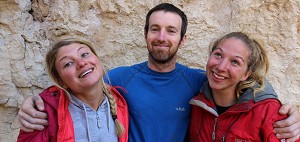

As Brits we tend to love the stories, the history and the legendary characters that surround the sport. Generally these stories will be of UK trad and of British characters such as Johnny Dawes or Jerry Moffatt. Among a few others, Ron Kauk is familiar American name among the British, despite having travelled all the way across the ocean. He is best known for the hard climbing he did in the Yosemite Valley area, mainly in the 70's. He made the first free ascent of Astroman with John Long and John Bachar the famous 5.11 on Washington Column, which was the hardest free route in the valley at the time, and remained so for the next 10 or so years. He was also the first to free the awesome roof crack Separate Reality. Amusingly enough, he also trained and doubled Sylvester Stallone in Cliffhanger. His most famous boulder problem - probably because it's the most famous boulder problem in the world - is Midnight Lightning, in Camp 4, Yosemite. Although this problem is rated a mere V8, and is therefore no longer cutting edge, many of Kauk's hard single pitch trad routes have yet to have seen a second repeat. Magic Line, 14b is one of them and Crossroads, 13d, has only been repeated by his son Lonnie (whom this interview is about) and Alex Honnold, despite being located in Yosemite, a honey pot for all the world's best traditional climbers.
Some of you may know these things already, but what you might not know is that Ron Kauk spawned a son, who maybe for slightly different reasons also deserves a little of his own legendary status. Lonnie has become a very talented boulderer establishing and repeating many of the hard lines in the Sierras. To name a few: Mandala, V12, Buttermilks; Evolution Direct, V11, Buttermilks; Thunderbird, V12, Tuolumne Meadows; Heroun and the Sea of Stories, V12, Buttermilks; Thriller, V10, Yosemite, Ghost Dance, V10, high ball at Way Lake (first ascent). He has also repeated some hard routes including his father's route Crossroads, 13d, Yosemite; Father's Day, 14a, Lake Tahoe. His own first ascent Thunderheart, 14a, Tioga Pass; Peace, 13c, Tuolumne Meadows and even onsighted the 20 plus pitches of the free variation of the Regular Route on Half Dome.
But what really sets Lonnie apart is the fact that he has reached an elite level in not only climbing, but another completely different sport as well: snowboarding. It's hard for a non-snowboarder like myself to quantify how good he is, but the fact that he is sponsored by Monster Energy, Lobster Snowboards, (among many others) and has filmed with Standard Films for 5 years and got a decent part in the snowboarding film 'BlackWinter' should indicate the fact that he's at least an 'E9 snowboarder'. Not many people can say that they have reached a professional level in two completely different sports.
Lonnie is also an interesting character. Not only did he grow up in Yosemite Valley, his mother is full blood Native American, from the Ahwahneechee Tribe in Yosemite. Lonnie's ancestors were living off the land in the Yosemite area long before climbers ever thought to climb El Cap. In this interview I've asked Lonnie what his thoughts are on his climbing, his father's and also the long history of Yosemite Valley. Enjoy!
Hazel: Do you think that both snowboarding and climbing require a certain something from you, and because of this the two sports end up complimenting each other quite nicely?
Lonnie: I think they're the two best things too do in the world and they work perfectly together. Climbing teaches you a lot about how too put every move together; you have too think and feel about what you're doing and put it into action, every move every thought and feeling matters and you have to truly live in the moment. Snowboarding is a lot of that as well but the important difference is that you have too pretty much free-solo every trick you want to learn. There's no 'take me' or 'hold me here' in the middle of the air, or 'wait I want to check this move'. You pretty much have to send a trick, or big mountain line after just thinking about it, which could be for many days or even years. Snowboarding requires a lot of mental power, whereas climbing requires a lot of mental strength and physical strength. Getting to a high level in climbing is pretty heavy since you have to rise to both of these strengths. A snowboarder with a really strong mind and technique can imagine a trick and just do it the first time, without any endurance or beta at all. Can you imagine climbing 5.14 from just thinking about it? With no endurance or beta? In climbing it's no good to just have 5.14 mental strength, you need the physical strength as well.
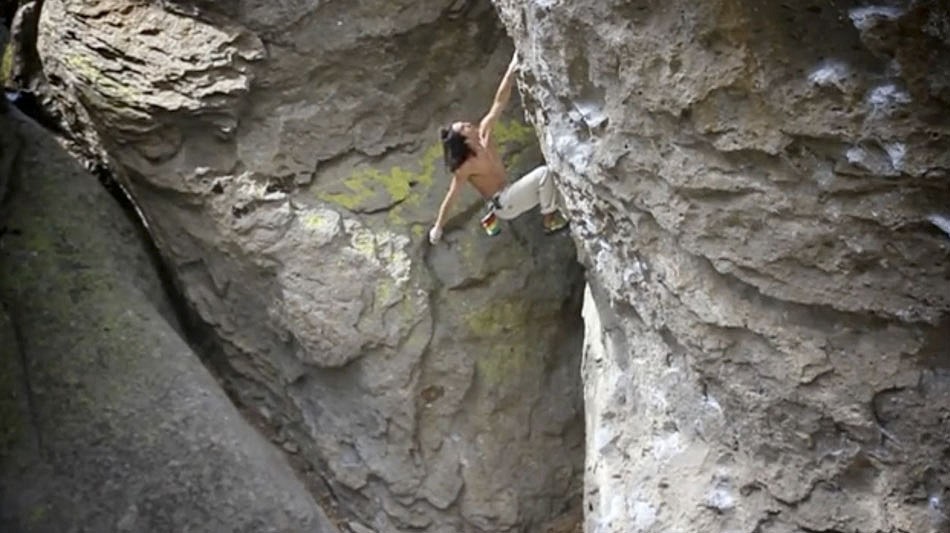
Hazel: I met you under Midnight Lightning. You absolutely breezed up it, literally like a leaf in the wind. Given that your Dad did the first ascent of this iconic problem and you must have grown up watching people test themselves on this boulder, what does the problem mean to you and how did it feel when you first did it?
Lonnie: I feel so close to this boulder. I wasn't even born when my dad made the first ascent. When I first started climbing, the first thing I wanted to climb was Midnight Lightning; I hadn't even done a V4 or even led a climb at all but it just felt so close to me. So one day me and my brother Yuodde walked over to it and started too try it, after a couple weeks I made it to the lip and it gave me so much energy, I could feel something grow inside. My Dad couldn't believe I had made it to the lip so fast, I hadn't even told him I was going over there in the first place. After he found out he was psyched to spot me and was there the day I did it. It was getting dark, I gave it a few great tries making it to the lip each time and then all of a sudden my mom showed up. It was just me, my Mom and my Dad at the boulder and I thought I'll just give it one more try. I made it to the lip, got my foot up, started to mantel over, locked in, reached up, quietly grabbed the hold and stood up! Then I climbed very controlled and quietly to the top. Dad climbed up the tree to meet me on the top and told me, "man that was pretty good son". I felt the powerful feeling inside; it was so great to have my mom and dad there for that very special moment. Now every time I do it I feel something click inside with all the spirit in Camp 4, doing it felt like an initiation into the climbing world.
Hazel: I have been told that you are a direct descendant of Chief Tenaya, the last leader of the Ahwahneechee tribe in Yosemite. How interested are you in this ancestry, does it mean a lot to you?
Lonnie: I was born in Yosemite and I grew up with my grandparents in the valley. My grandpa is full blood Paiute (one of the last ones) and my grandma still works at the native museum in the valley. She is one of the most famous basket weaver's in the world and was taught by my great grandma Lucy Telles, one of the greatest basket weavers of all time. The people of Yosemite were very powerful medicine people with many stories of Magician's, Healers and Shamans. The spirit still runs deep in Yosemite, and the fact that I carry that same spirit and bloodline is very special to me. I feel it when I climb all around; from Yosemite to Bishop to Lake Tahoe; it feels like I've been here before, running the same land. And to be here now, climbing and snowboarding in the same mountains, I know I have a connection with this place. I want to show my people that, things like climbing and snowboarding are great ways to reconnect with the land and spirit that's still here.
Hazel: How much do you regard yourself as Native American? What are your thoughts about the history of first nation Americans, how profoundly their lives were changed by mass immigration from Europe and the subsequent discrimination, which still exists today?
Lonnie: I feel very proud to have this spirit and bloodline run through me. My grandparents taught me when I was a kid that we are connected to this land, that our spirit is here. We were for thousands of years living off the land, living with the great spirit, but when the people showed up with a different way of doing things, a different way of life and didn't allow the natives to follow their way, they tried too kill our spirit. Many battles were fought, many people were killed and blood was spilt all over this country, for greed and for not understanding who we are. Now it's OK, but very hard for some people to find their way of life. In America you're always told what to do and what to be. Luckily there are things like climbing and snowboarding that bring so much to your life. They give you a way to be free and a way to connect with the land, with the rock, with the mountains and with the seasons. The native spirit is still strong and as long as it's used right it will continue to shine bright! And that is the path I take.
Hazel: You seem very connected to Yosemite, how do you feel about what the valley has become compared to its natural state. Does the fact that you can drive into the valley and buy a burger sit well with you, or would you prefer it to be different?
Lonnie: Yes I'm so connected to Yosemite, but it's more like a amusement park now. For example I remember people asking me, "when do they turn on the water falls?" or, "when do they let the animals out?" I always thought where is their mind? But society's dream is not feeding people to connect with their spirit or heart as much as they could, if it did then maybe it would be different today. As kids, Yosemite was an amazing place to grow up, but once we started to grow up the rangers would mess with us and look at us like we were trouble, but we were all nice kids.
Hazel: Your father, Ron Kauk, wasn't just a talent of his generation, the fact that many of his routes have seen few repeats, or in some cases, no second ascent shows that he would be a world class climber today as well. How does it feel to be the son of such a legend?
Lonnie: It's pretty cool that not too many climbers have repeated his routes; it proves his unique style of climbing. I think its cool to have a father like him and what he has accomplished in Yosemite with climbing but he didn't push me to climb at all, or be what I am today. I just sat back and watched the time go by, in middle school I was dreaming, "should I be a pro skateboarder or snowboarder?" But I never thought to be a climber because I didn't know anything about it other than what I had seen as a kid. We saw dad climb on the videos like Masters of Stone, he was more like a dissident hero. When I found climbing for myself, I felt something inside; it felt like it was in my blood to do this. Whether it's hard climbing or not, it's in my soul and I can feel it every time I go climbing. Now I've climbed a bunch of his routes like Crossroads, 13d, Peace, 13c, Sacred Fire, 13a, Thriller, V10, Midnight Lightning, V8. Pretty cool to think that when I was growing up I was looking at photos of all these routes and I wasn't even climbing at the time.
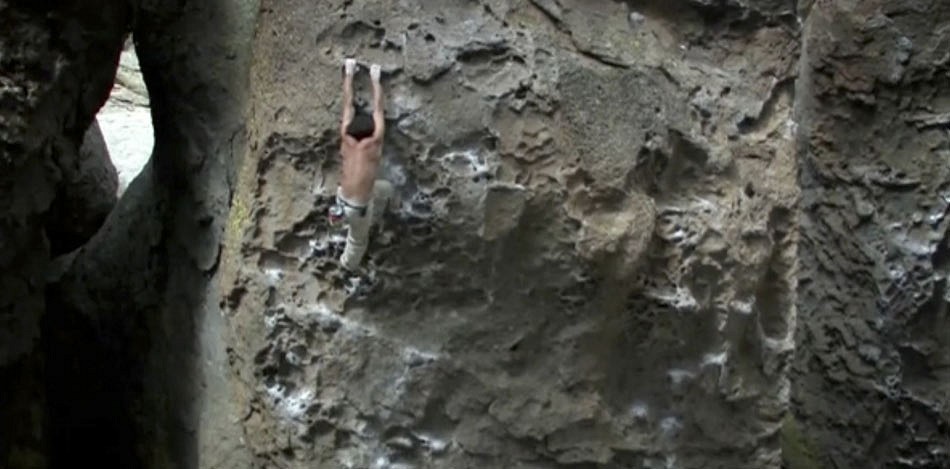
Hazel: When I met you last year, you had done one of his harder routes, Crossroads a rarely repeated 13d. Did you enjoy trying to do this route? This route (among others) was rap bolted by your Dad, which at the time went against Yosemite ethics. What are your thoughts on the whole rap-bolting versus ground up bolting debate in Yosemite and in general?
Lonnie: It's all climbing in the end as long as it's fun and respectful it's all good. Crossroads was an amazing process, such a cool thing to see that cover shot Dad had with Climbing magazine when I didn't even climb, then years later here I was ready to try it. I worked it pretty hard, battling with warm conditions and knowing this was a great route, really technical with so many great moves. It was an awesome day the day I did it with dad belaying me. The first go of the day I fell at the top techy section, I was so stoked, lowered off and rested for a while listening to Led Zeppelin looking at the sunset. It was golden; I was feeling some great vibes with Zeppelin playing feeling really close to the rock. On my next try I started to climb, feeling very free with no thought of making it or falling just enjoying every move and trying my best. All of a sudden I was at the same technical section feeling pretty good and not too pumped. I made it to the ledge, slowly stood up, gave my thanks to the process and clipped the anchor. I lowered off, gave dad a hug, it was one of the first times I had seen that look in his eyes. Such a great time forever saved.
Hazel: And finally... you struck me as quite a philosophical person, but also someone who doesn't like to take things too seriously. Have you got words of wisdom for us Lonnie?
Lonnie: Always be yourself, have fun, enjoy the journey and put your heart and soul into everything you do, it will shine!
Thanks to Lonnie and DPM Climbing for their help with this interview.

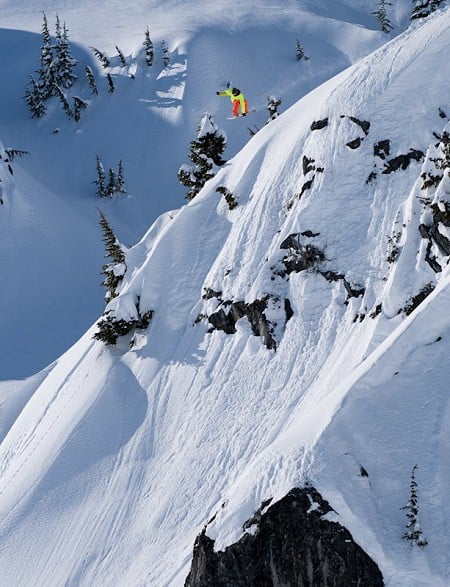
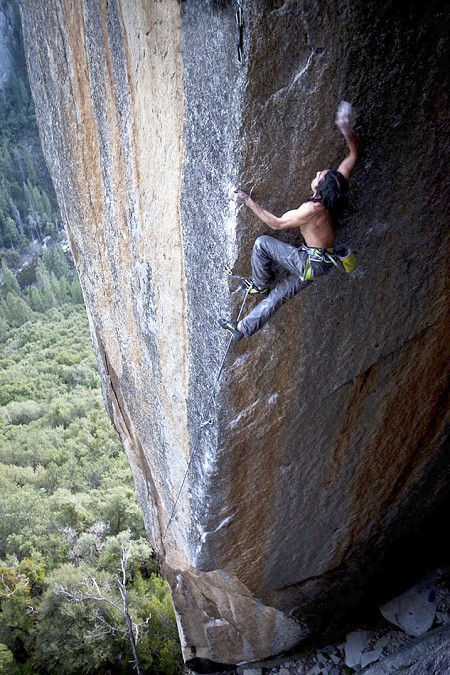

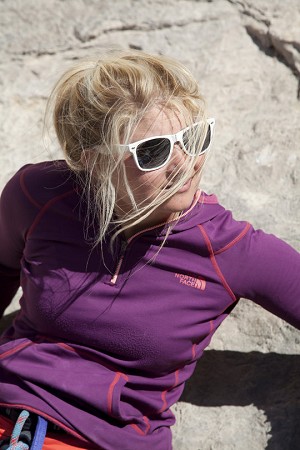
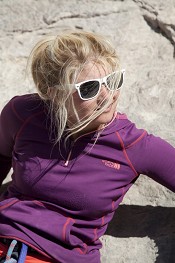
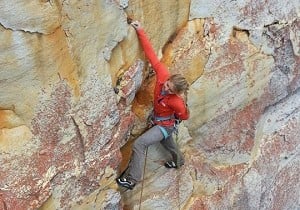
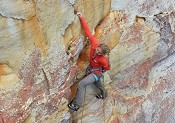




Comments